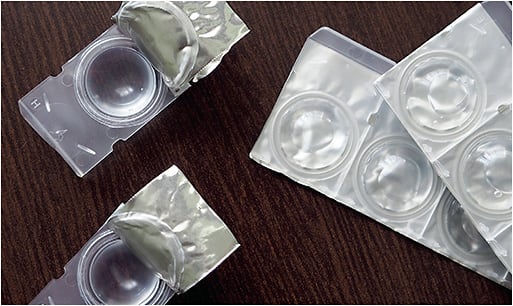Consumers certainly have plenty of options when it comes to purchasing their lenses: big box stores, numerous online retailers, pharmacies and, of course, us, their independent optometrist. We write 90% of contact lens prescriptions, reports an article in Contact Lens Spectrum. Further, the independent optometric practice derives approximately 17% of its revenue from contact lens sales, not including the services that go along with contact lens care, such as fitting, the sale of solutions and non-prescription sunglasses. Clearly, contact lenses are a significant revenue center for us. Add this to optometrists’ genuine concern for patients’ ocular health, vision and comfort, and the goal should be to increase the probability patients don’t go anywhere else to buy their lenses.
Here are 10 steps that can accomplish this goal, based on my personal practice experience.
1 BECOME AN EXPERT
Give patients a reason to give you their full confidence and, therefore, their hard-earned dollars, when it comes to all things contact lenses by becoming an expert.
To accomplish this, learn as much as you can, via journal articles, lectures, webinars, etc., including about therapeutic and medically necessary fitting. Additionally, consider becoming involved in one or more contact lens organizations, such as the AOA Contact Lens and Cornea Section (bit.ly/394Sm2u ) and the AAO Section on Cornea, Contact Lenses and Refractive Technologies (bit.ly/3lOx3pC ). All these methods will enable you to meet others interested in contact lenses and can help you expand your knowledge, which can translate to patient trust and, therefore, their investment in the specific products you provide.

2 MEET PATIENT NEED
Meet all your patients’ contact lens needs, be they optimal vision, comfort, ease-of-use, or individual needs, such as “I’m looking for lenses I can wear while playing sports.” In doing so, optometrists provide patients the peace of mind that you genuinely care about the patient’s overall eye health. This peace can convert to patient trust and appreciation, and, therefore, lead to the purchase of the specific contact lenses and related products you offer.
3 PROVIDE PATIENT EDUCATION
Compile all the benefits patients get from your practice vs. the big-box stores, online retailers and pharmacies, and include them in a patient education sheet, side-by-side, so patients can see what they’ll miss when they decide to fill their contact lens prescription elsewhere.
4 UTILIZE SERVICE AGREEMENTS
As a reminder, contact lens service agreements require the patient to pay a yearly fee up-front. This fee covers any contact lens-related service in the practice and provides the patient a significantly deeper discount on their contact lens materials. Since this fee is paid ahead of time, it ties the patient to the practice for a full year, again making the patient less likely to shop around.

Additionally, with a service agreement in place, patients tend not to put off needed care in the instance of a problem, such as ocular dryness. We have made use of service agreements in our practice for many years and continue to find them effective.
5 BE FAIR/COMPETITIVE
Charge a fair fee for the contact lens services you provide, and offer product at a competitive rate, so patients have no reason to go elsewhere. (See “How to Set Your Fitting Fees” at bit.ly/3kQuSR4 .)
Many years ago, my then future mentor, Robert A. Koetting, O.D., lectured to my third-year class at the Illinois College of Optometry and posed the question: “What would you charge if contact lenses were free?” Nearly 40 years ago there were no disposable lenses, so that was quite a bold and thought-provoking question. Indeed, Dr. Koetting’s comment was prophetic: Even then he saw the need to de-emphasize materials and charge instead for the services and expertise we offer.
6 USE STATE-OF-THE-ART EQUIPMENT
Equipping your practice with contact lens fitting-related devices improves the quality of care you provide, further instilling confidence and loyalty in your patients. State-of-the-art instrumentation can include a corneal topographer, pachymeter, OCT, endothelial cell analyzer, a device that measures the radius of curvature of the anterior and posterior surfaces of an RGP lens and a modification unit that performs lens polishing and edge and secondary curve adjustment on the spot.
7 OFFER SPECIALTY LENSES
In addition to helping patients improve their quality of vision and life, specialty contact lenses are not offered by retailers, so prescribing them is truly a win-win. While many patients will do just fine with spherical disposable soft lenses, I have found that a significant number do better with a GP. This is because, often, visual quality may be improved with a GP. Further, specialty contact lenses, such as sclerals and hybrids, can be excellent problem-solvers and can enable patients who have been told they weren’t candidates for lens wear to achieve wear.
The bottom line here is that these sophisticated designs can produce successful patients who are more likely to continue to purchase lenses through your practice and refer their friends to boot!
8 MAKE IT EASY
Who doesn’t want convenience when it comes to purchasing products? After all, we live in a busy and hectic world. Enable patients who have undergone their annual exam and/or contact lens-fitting appointment to order their contact lenses online through e-commerce platforms via your website. (For additional information, see “Consider an E-Commerce Platform” at bit.ly/2KtpHdl .) Also, offer an annual contact lens supply, which, in addition to its convenience, provides patients with large manufacturer rebates. These are, sometimes, even larger through a doctor’s office. (Remember: Once your patient purchases an annual supply, they are no longer in the market for a full year.)
Further, be open to taking contact lens orders by phone and, occasionally, providing a courier service if a patient is in a desperate situation, as might be the case for a GP lens wearer who has lost or damaged a lens.
Providing convenience and going above and beyond what is expected can enable you to keep contact lens sales.
9 BE FLEXIBLE
Have an “open box” policy when it comes to exchanging boxes of lenses through annual supplies. This reassures patients that they will not be “stuck” with an abundance of lenses, should their prescription require change within the year. Patients are not likely to find this kind of flexibility from a major retailer.
10 INVENTORY YOUR PREFERRED BRANDS
The ability to hand patients all the lenses they will need for a full year is a tremendous added convenience that can help set your practice apart from the big box stores, numerous on-line retailers and pharmacies.
Probably one of the biggest practice builders my practice has employed over the years is to carry an inventory of standard GP lenses. We continue to see a relatively high percentage of rigid GP lens wearers, and for them to be able to come in and leave with a new pair of lenses is extremely gratifying for us and much appreciated by those patients.
PATIENT DESIRES
Patients who shop for their contact lenses generally do so for cost, convenience or both. The strategies discussed above are designed to meet those patient desires, while reminding them of the unparalleled service they receive from their optometrists. I have found these steps go a long way toward producing happy and healthy patients and a healthy practice. OM




